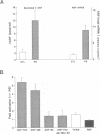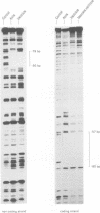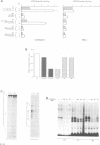Abstract
alpha 1-Adrenergic agonists and antagonists constitute an important class of therapeutic agents commonly used for the treatment of various cardiovascular diseases like hypertension, congestive heart failure and supraventricular tachycardia. At the heart level, activation of alpha 1-adrenergic receptors is associated with marked morphological and genetic changes. These include enhancement of contractility, myocardial growth (hypertrophy) and release of the heart major secretory product, atrial natriuretic factor (ANF). However, the signal transduction pathways which link extracellular activation of the receptors to cellular and genetic changes are not well understood. Using primary cardiocyte cultures from neonate rat hearts, an alpha 1-adrenergic regulatory sequence has been identified in the 5' flanking region of the ANF gene. This sequence, which is necessary and sufficient for transcriptional activation in response to the alpha 1-specific agonist phenylephrine, interacts with novel zinc-dependent proteins which are induced by alpha 1-adrenergic stimulation. Consistent with a conserved regulatory mechanism, the alpha 1 response element is highly conserved between rodent, bovine and human ANF genes, and is also present in the promoter region of other alpha 1-responsive cardiac genes. The identification of a nuclear pathway for alpha 1-receptor signaling will be useful for elucidating the intracellular effectors of alpha 1-adrenergic receptors.
Full text
PDF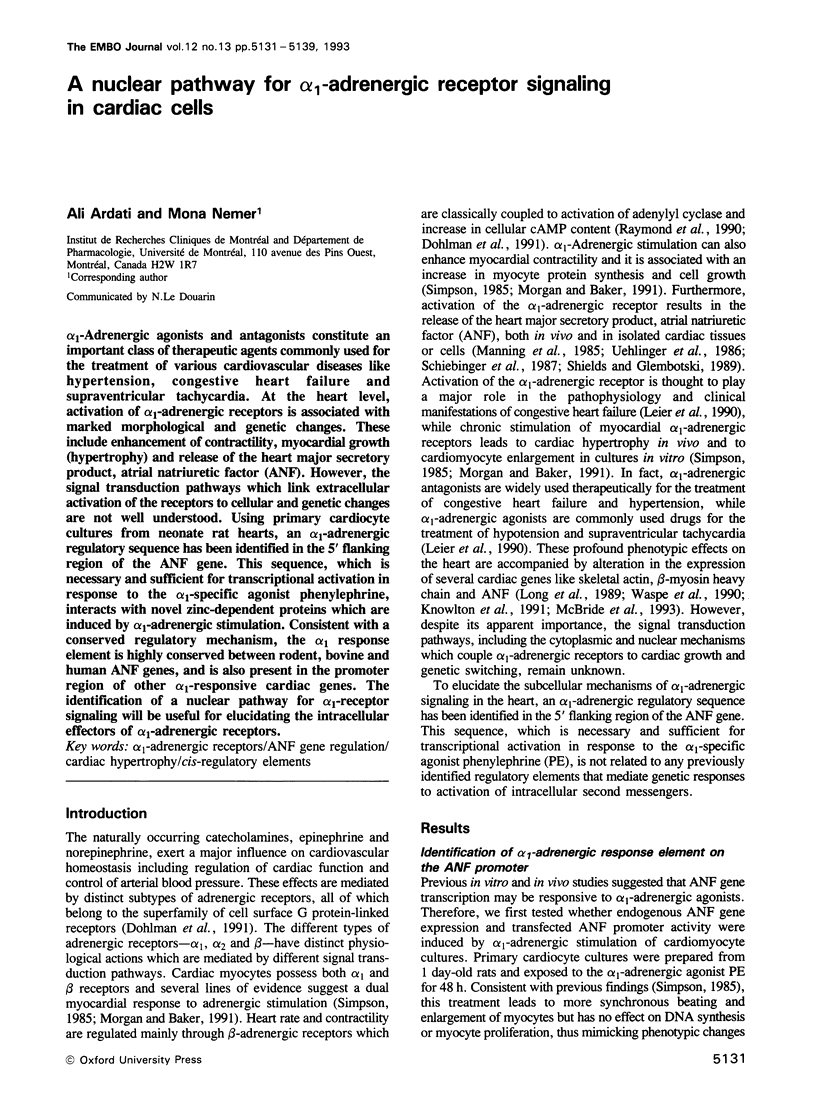
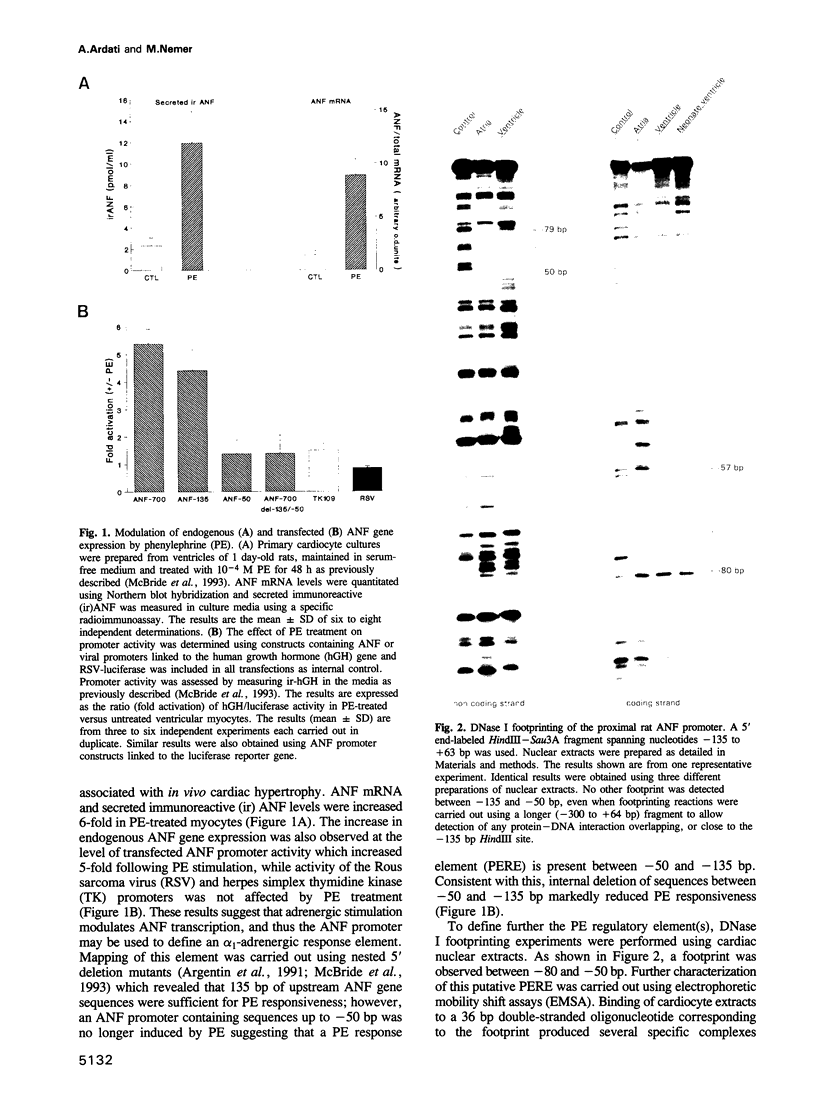
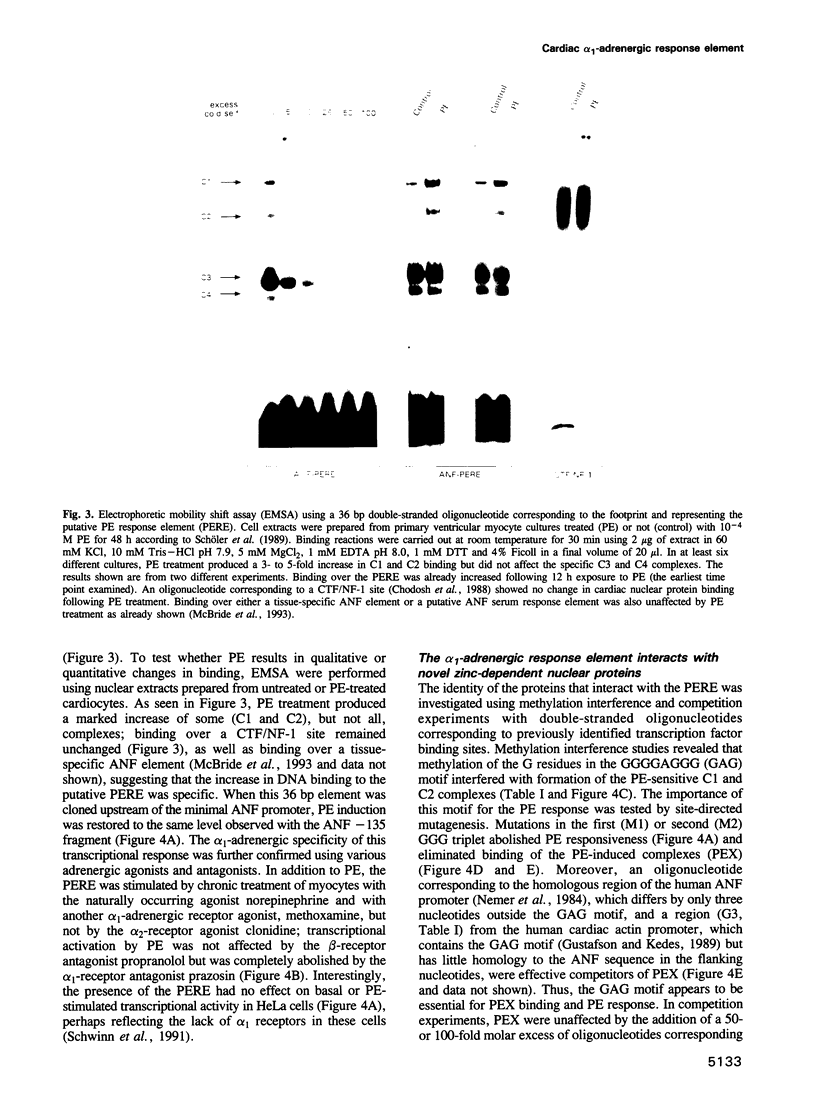
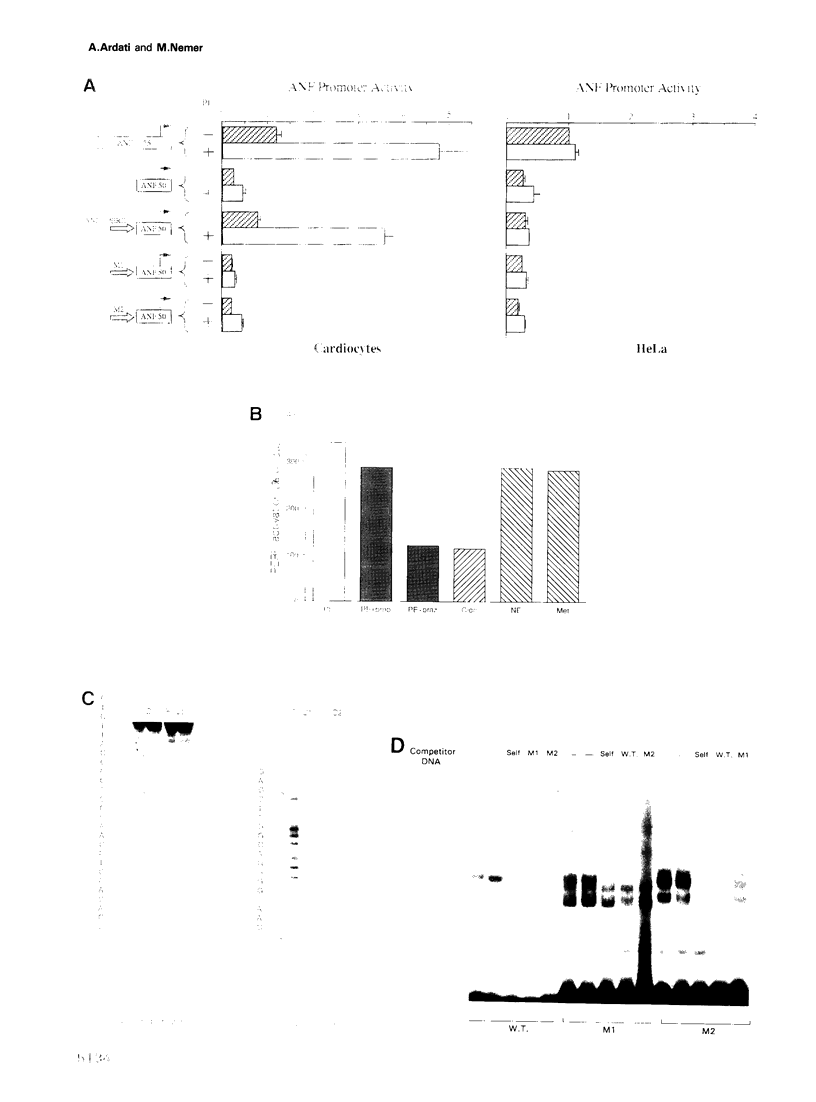
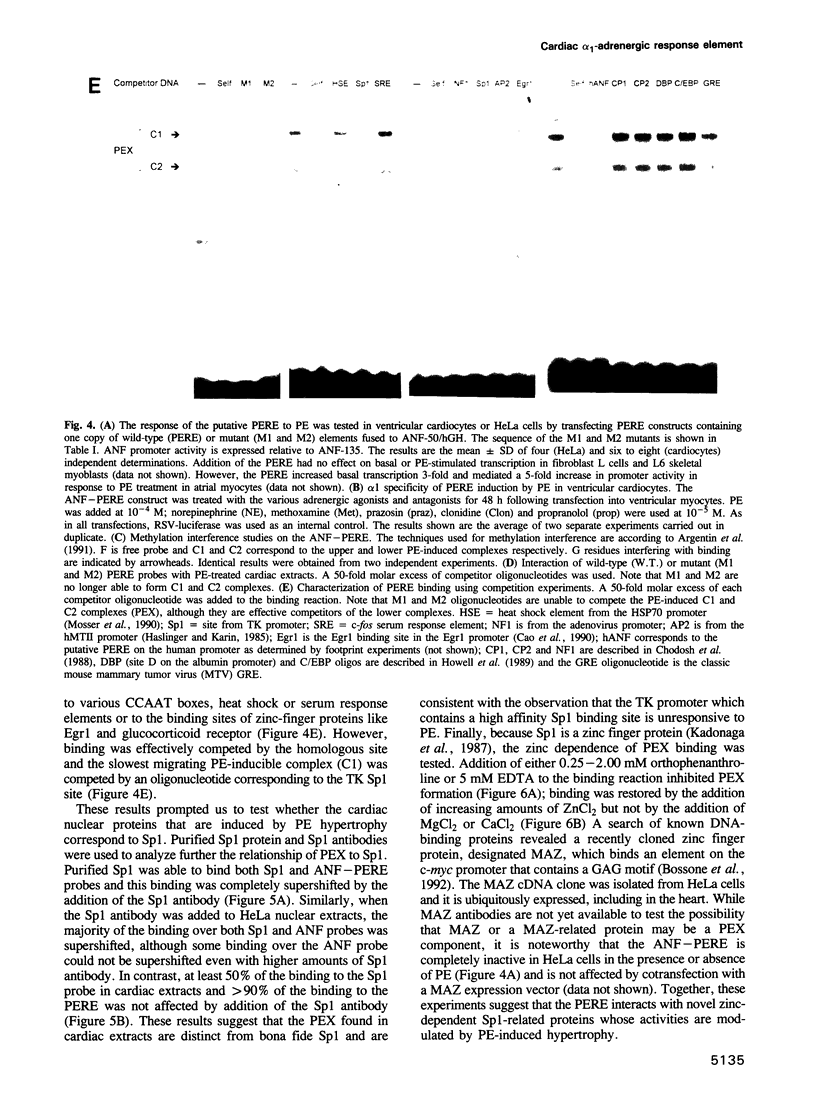
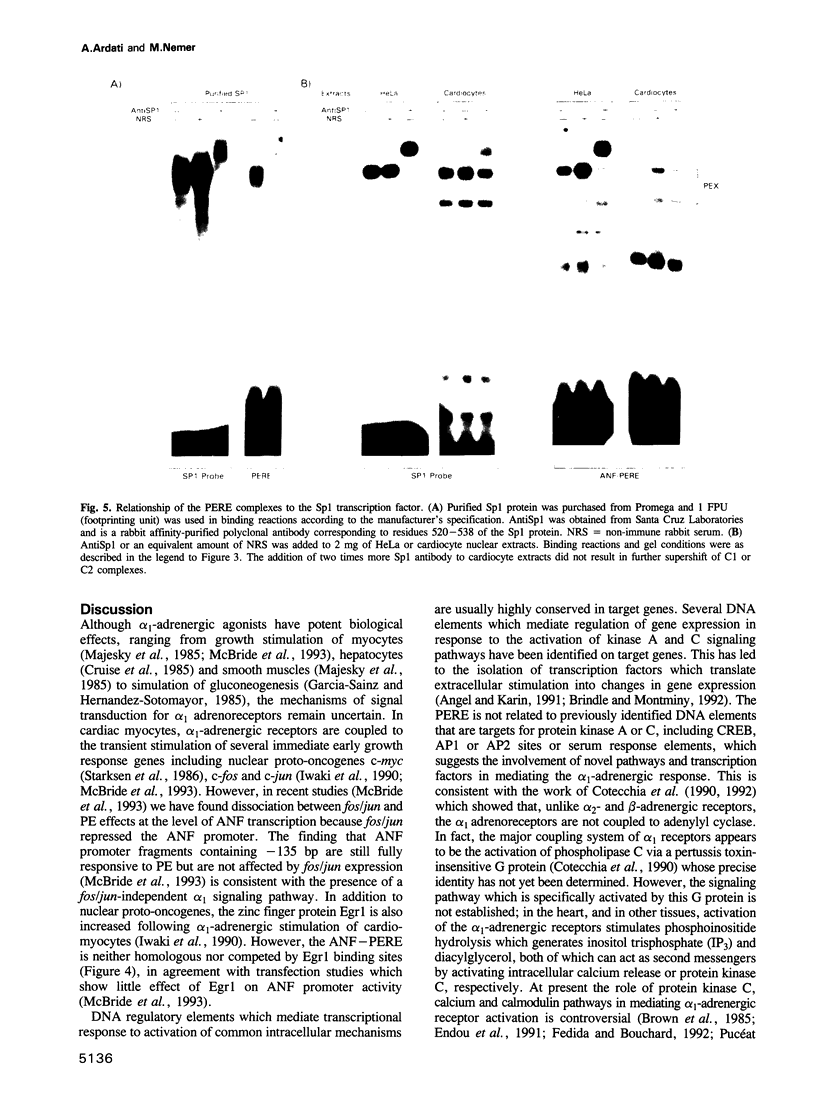
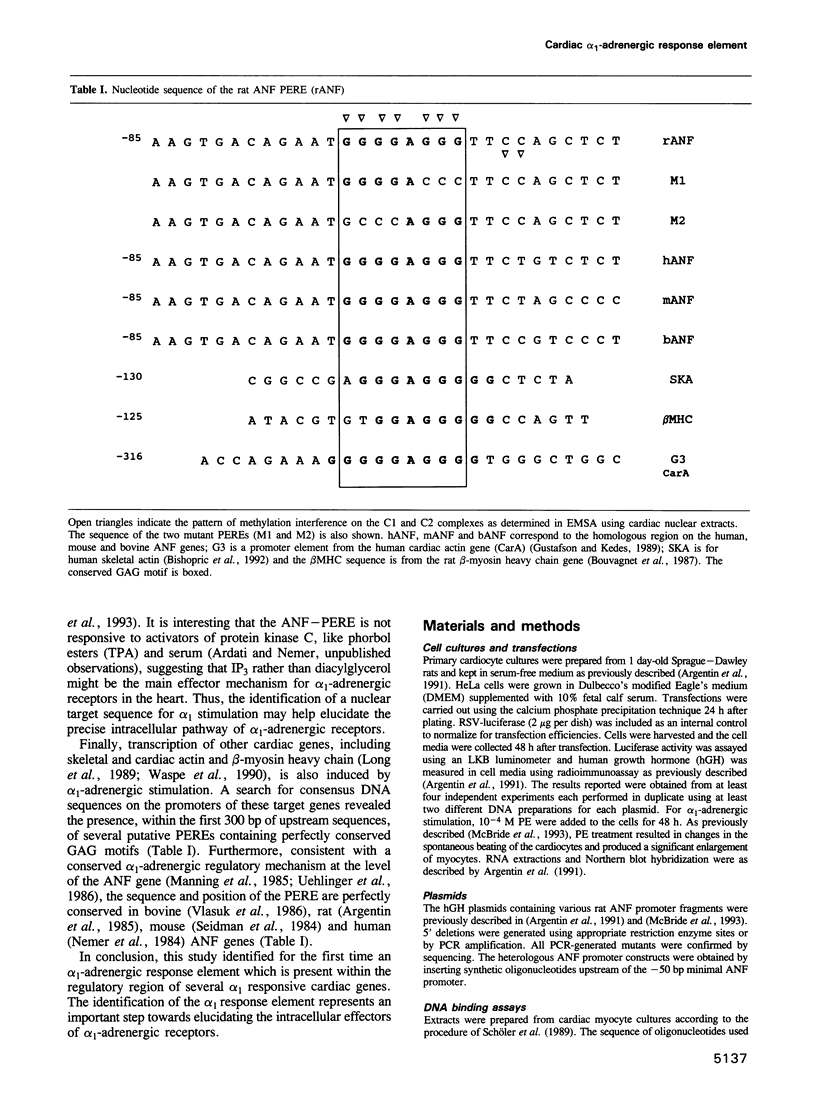
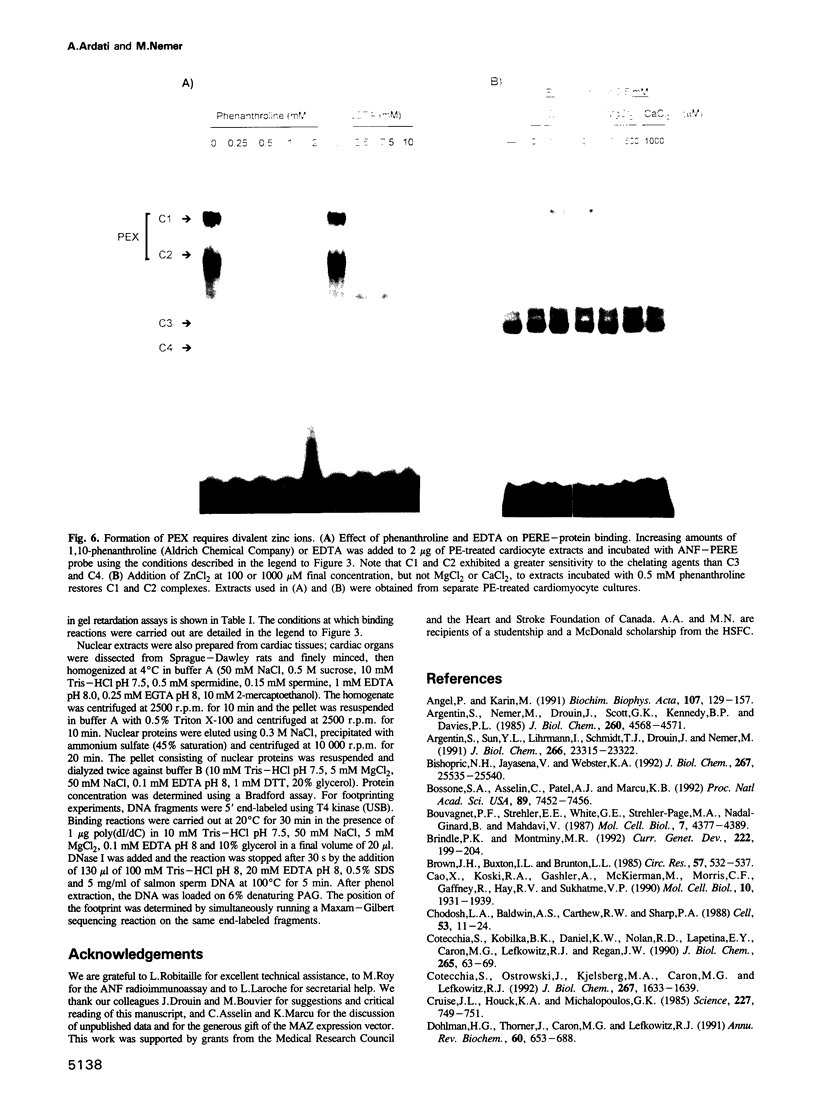
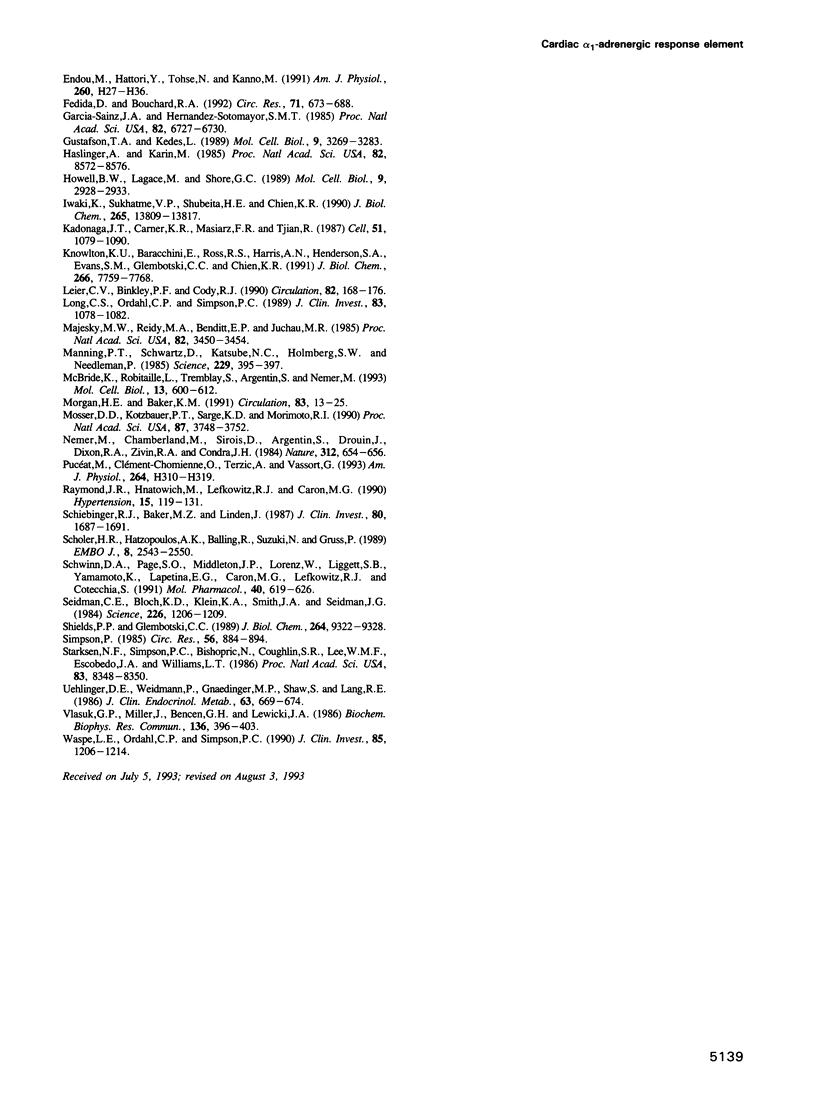
Images in this article
Selected References
These references are in PubMed. This may not be the complete list of references from this article.
- Angel P., Karin M. The role of Jun, Fos and the AP-1 complex in cell-proliferation and transformation. Biochim Biophys Acta. 1991 Dec 10;1072(2-3):129–157. doi: 10.1016/0304-419x(91)90011-9. [DOI] [PubMed] [Google Scholar]
- Argentin S., Nemer M., Drouin J., Scott G. K., Kennedy B. P., Davies P. L. The gene for rat atrial natriuretic factor. J Biol Chem. 1985 Apr 25;260(8):4568–4571. [PubMed] [Google Scholar]
- Argentin S., Sun Y. L., Lihrmann I., Schmidt T. J., Drouin J., Nemer M. Distal cis-acting promoter sequences mediate glucocorticoid stimulation of cardiac atrial natriuretic factor gene transcription. J Biol Chem. 1991 Dec 5;266(34):23315–23322. [PubMed] [Google Scholar]
- Bishopric N. H., Jayasena V., Webster K. A. Positive regulation of the skeletal alpha-actin gene by Fos and Jun in cardiac myocytes. J Biol Chem. 1992 Dec 15;267(35):25535–25540. [PubMed] [Google Scholar]
- Bossone S. A., Asselin C., Patel A. J., Marcu K. B. MAZ, a zinc finger protein, binds to c-MYC and C2 gene sequences regulating transcriptional initiation and termination. Proc Natl Acad Sci U S A. 1992 Aug 15;89(16):7452–7456. doi: 10.1073/pnas.89.16.7452. [DOI] [PMC free article] [PubMed] [Google Scholar]
- Bouvagnet P. F., Strehler E. E., White G. E., Strehler-Page M. A., Nadal-Ginard B., Mahdavi V. Multiple positive and negative 5' regulatory elements control the cell-type-specific expression of the embryonic skeletal myosin heavy-chain gene. Mol Cell Biol. 1987 Dec;7(12):4377–4389. doi: 10.1128/mcb.7.12.4377. [DOI] [PMC free article] [PubMed] [Google Scholar]
- Brindle P. K., Montminy M. R. The CREB family of transcription activators. Curr Opin Genet Dev. 1992 Apr;2(2):199–204. doi: 10.1016/s0959-437x(05)80274-6. [DOI] [PubMed] [Google Scholar]
- Brown J. H., Buxton I. L., Brunton L. L. Alpha 1-adrenergic and muscarinic cholinergic stimulation of phosphoinositide hydrolysis in adult rat cardiomyocytes. Circ Res. 1985 Oct;57(4):532–537. doi: 10.1161/01.res.57.4.532. [DOI] [PubMed] [Google Scholar]
- Cao X. M., Koski R. A., Gashler A., McKiernan M., Morris C. F., Gaffney R., Hay R. V., Sukhatme V. P. Identification and characterization of the Egr-1 gene product, a DNA-binding zinc finger protein induced by differentiation and growth signals. Mol Cell Biol. 1990 May;10(5):1931–1939. doi: 10.1128/mcb.10.5.1931. [DOI] [PMC free article] [PubMed] [Google Scholar]
- Chodosh L. A., Baldwin A. S., Carthew R. W., Sharp P. A. Human CCAAT-binding proteins have heterologous subunits. Cell. 1988 Apr 8;53(1):11–24. doi: 10.1016/0092-8674(88)90483-7. [DOI] [PubMed] [Google Scholar]
- Cotecchia S., Kobilka B. K., Daniel K. W., Nolan R. D., Lapetina E. Y., Caron M. G., Lefkowitz R. J., Regan J. W. Multiple second messenger pathways of alpha-adrenergic receptor subtypes expressed in eukaryotic cells. J Biol Chem. 1990 Jan 5;265(1):63–69. [PubMed] [Google Scholar]
- Cotecchia S., Ostrowski J., Kjelsberg M. A., Caron M. G., Lefkowitz R. J. Discrete amino acid sequences of the alpha 1-adrenergic receptor determine the selectivity of coupling to phosphatidylinositol hydrolysis. J Biol Chem. 1992 Jan 25;267(3):1633–1639. [PubMed] [Google Scholar]
- Cruise J. L., Houck K. A., Michalopoulos G. K. Induction of DNA synthesis in cultured rat hepatocytes through stimulation of alpha 1 adrenoreceptor by norepinephrine. Science. 1985 Feb 15;227(4688):749–751. doi: 10.1126/science.2982212. [DOI] [PubMed] [Google Scholar]
- Dohlman H. G., Thorner J., Caron M. G., Lefkowitz R. J. Model systems for the study of seven-transmembrane-segment receptors. Annu Rev Biochem. 1991;60:653–688. doi: 10.1146/annurev.bi.60.070191.003253. [DOI] [PubMed] [Google Scholar]
- Endou M., Hattori Y., Tohse N., Kanno M. Protein kinase C is not involved in alpha 1-adrenoceptor-mediated positive inotropic effect. Am J Physiol. 1991 Jan;260(1 Pt 2):H27–H36. doi: 10.1152/ajpheart.1991.260.1.H27. [DOI] [PubMed] [Google Scholar]
- Fedida D., Bouchard R. A. Mechanisms for the positive inotropic effect of alpha 1-adrenoceptor stimulation in rat cardiac myocytes. Circ Res. 1992 Sep;71(3):673–688. doi: 10.1161/01.res.71.3.673. [DOI] [PubMed] [Google Scholar]
- García-Sáinz J. A., Hernández-Sotomayor S. M. Adrenergic regulation of gluconeogenesis: possible involvement of two mechanisms of signal transduction in alpha 1-adrenergic action. Proc Natl Acad Sci U S A. 1985 Oct;82(20):6727–6730. doi: 10.1073/pnas.82.20.6727. [DOI] [PMC free article] [PubMed] [Google Scholar]
- Gustafson T. A., Kedes L. Identification of multiple proteins that interact with functional regions of the human cardiac alpha-actin promoter. Mol Cell Biol. 1989 Aug;9(8):3269–3283. doi: 10.1128/mcb.9.8.3269. [DOI] [PMC free article] [PubMed] [Google Scholar]
- Haslinger A., Karin M. Upstream promoter element of the human metallothionein-IIA gene can act like an enhancer element. Proc Natl Acad Sci U S A. 1985 Dec;82(24):8572–8576. doi: 10.1073/pnas.82.24.8572. [DOI] [PMC free article] [PubMed] [Google Scholar]
- Howell B. W., Lagacé M., Shore G. C. Activity of the carbamyl phosphate synthetase I promoter in liver nuclear extracts is dependent on a cis-acting C/EBP recognition element. Mol Cell Biol. 1989 Jul;9(7):2928–2933. doi: 10.1128/mcb.9.7.2928. [DOI] [PMC free article] [PubMed] [Google Scholar]
- Iwaki K., Sukhatme V. P., Shubeita H. E., Chien K. R. Alpha- and beta-adrenergic stimulation induces distinct patterns of immediate early gene expression in neonatal rat myocardial cells. fos/jun expression is associated with sarcomere assembly; Egr-1 induction is primarily an alpha 1-mediated response. J Biol Chem. 1990 Aug 15;265(23):13809–13817. [PubMed] [Google Scholar]
- Kadonaga J. T., Carner K. R., Masiarz F. R., Tjian R. Isolation of cDNA encoding transcription factor Sp1 and functional analysis of the DNA binding domain. Cell. 1987 Dec 24;51(6):1079–1090. doi: 10.1016/0092-8674(87)90594-0. [DOI] [PubMed] [Google Scholar]
- Knowlton K. U., Baracchini E., Ross R. S., Harris A. N., Henderson S. A., Evans S. M., Glembotski C. C., Chien K. R. Co-regulation of the atrial natriuretic factor and cardiac myosin light chain-2 genes during alpha-adrenergic stimulation of neonatal rat ventricular cells. Identification of cis sequences within an embryonic and a constitutive contractile protein gene which mediate inducible expression. J Biol Chem. 1991 Apr 25;266(12):7759–7768. [PubMed] [Google Scholar]
- Long C. S., Ordahl C. P., Simpson P. C. Alpha 1-adrenergic receptor stimulation of sarcomeric actin isogene transcription in hypertrophy of cultured rat heart muscle cells. J Clin Invest. 1989 Mar;83(3):1078–1082. doi: 10.1172/JCI113951. [DOI] [PMC free article] [PubMed] [Google Scholar]
- Majesky M. W., Reidy M. A., Benditt E. P., Juchau M. R. Focal smooth muscle proliferation in the aortic intima produced by an initiation-promotion sequence. Proc Natl Acad Sci U S A. 1985 May;82(10):3450–3454. doi: 10.1073/pnas.82.10.3450. [DOI] [PMC free article] [PubMed] [Google Scholar]
- Manning P. T., Schwartz D., Katsube N. C., Holmberg S. W., Needleman P. Vasopressin-stimulated release of atriopeptin: endocrine antagonists in fluid homeostasis. Science. 1985 Jul 26;229(4711):395–397. doi: 10.1126/science.2990050. [DOI] [PubMed] [Google Scholar]
- McBride K., Robitaille L., Tremblay S., Argentin S., Nemer M. fos/jun repression of cardiac-specific transcription in quiescent and growth-stimulated myocytes is targeted at a tissue-specific cis element. Mol Cell Biol. 1993 Jan;13(1):600–612. doi: 10.1128/mcb.13.1.600. [DOI] [PMC free article] [PubMed] [Google Scholar]
- Morgan H. E., Baker K. M. Cardiac hypertrophy. Mechanical, neural, and endocrine dependence. Circulation. 1991 Jan;83(1):13–25. doi: 10.1161/01.cir.83.1.13. [DOI] [PubMed] [Google Scholar]
- Mosser D. D., Kotzbauer P. T., Sarge K. D., Morimoto R. I. In vitro activation of heat shock transcription factor DNA-binding by calcium and biochemical conditions that affect protein conformation. Proc Natl Acad Sci U S A. 1990 May;87(10):3748–3752. doi: 10.1073/pnas.87.10.3748. [DOI] [PMC free article] [PubMed] [Google Scholar]
- Nemer M., Chamberland M., Sirois D., Argentin S., Drouin J., Dixon R. A., Zivin R. A., Condra J. H. Gene structure of human cardiac hormone precursor, pronatriodilatin. Nature. 1984 Dec 13;312(5995):654–656. doi: 10.1038/312654a0. [DOI] [PubMed] [Google Scholar]
- Pucéat M., Clément-Chomienne O., Terzic A., Vassort G. Alpha 1-adrenoceptor and purinoceptor agonists modulate Na-H antiport in single cardiac cells. Am J Physiol. 1993 Feb;264(2 Pt 2):H310–H319. doi: 10.1152/ajpheart.1993.264.2.H310. [DOI] [PubMed] [Google Scholar]
- Raymond J. R., Hnatowich M., Lefkowitz R. J., Caron M. G. Adrenergic receptors. Models for regulation of signal transduction processes. Hypertension. 1990 Feb;15(2):119–131. doi: 10.1161/01.hyp.15.2.119. [DOI] [PubMed] [Google Scholar]
- Schiebinger R. J., Baker M. Z., Linden J. Effect of adrenergic and muscarinic cholinergic agonists on atrial natriuretic peptide secretion by isolated rat atria. Potential role of the autonomic nervous system in modulating atrial natriuretic peptide secretion. J Clin Invest. 1987 Dec;80(6):1687–1691. doi: 10.1172/JCI113258. [DOI] [PMC free article] [PubMed] [Google Scholar]
- Schwinn D. A., Page S. O., Middleton J. P., Lorenz W., Liggett S. B., Yamamoto K., Lapetina E. G., Caron M. G., Lefkowitz R. J., Cotecchia S. The alpha 1C-adrenergic receptor: characterization of signal transduction pathways and mammalian tissue heterogeneity. Mol Pharmacol. 1991 Nov;40(5):619–626. [PubMed] [Google Scholar]
- Schöler H. R., Hatzopoulos A. K., Balling R., Suzuki N., Gruss P. A family of octamer-specific proteins present during mouse embryogenesis: evidence for germline-specific expression of an Oct factor. EMBO J. 1989 Sep;8(9):2543–2550. doi: 10.1002/j.1460-2075.1989.tb08392.x. [DOI] [PMC free article] [PubMed] [Google Scholar]
- Seidman C. E., Bloch K. D., Klein K. A., Smith J. A., Seidman J. G. Nucleotide sequences of the human and mouse atrial natriuretic factor genes. Science. 1984 Dec 7;226(4679):1206–1209. doi: 10.1126/science.6542248. [DOI] [PubMed] [Google Scholar]
- Shields P. P., Glembotski C. C. Regulation of atrial natriuretic factor-(99-126) secretion from neonatal rat primary atrial cultures by activators of protein kinases A and C. J Biol Chem. 1989 Jun 5;264(16):9322–9328. [PubMed] [Google Scholar]
- Simpson P. Stimulation of hypertrophy of cultured neonatal rat heart cells through an alpha 1-adrenergic receptor and induction of beating through an alpha 1- and beta 1-adrenergic receptor interaction. Evidence for independent regulation of growth and beating. Circ Res. 1985 Jun;56(6):884–894. doi: 10.1161/01.res.56.6.884. [DOI] [PubMed] [Google Scholar]
- Starksen N. F., Simpson P. C., Bishopric N., Coughlin S. R., Lee W. M., Escobedo J. A., Williams L. T. Cardiac myocyte hypertrophy is associated with c-myc protooncogene expression. Proc Natl Acad Sci U S A. 1986 Nov;83(21):8348–8350. doi: 10.1073/pnas.83.21.8348. [DOI] [PMC free article] [PubMed] [Google Scholar]
- Uehlinger D. E., Weidmann P., Gnaedinger M. P., Shaw S., Lang R. E. Depressor effects and release of atrial natriuretic peptide during norepinephrine or angiotensin II infusion in man. J Clin Endocrinol Metab. 1986 Sep;63(3):669–674. doi: 10.1210/jcem-63-3-669. [DOI] [PubMed] [Google Scholar]
- Vlasuk G. P., Miller J., Bencen G. H., Lewicki J. A. Structure and analysis of the bovine atrial natriuretic peptide precursor gene. Biochem Biophys Res Commun. 1986 Apr 14;136(1):396–403. doi: 10.1016/0006-291x(86)90924-1. [DOI] [PubMed] [Google Scholar]
- Waspe L. E., Ordahl C. P., Simpson P. C. The cardiac beta-myosin heavy chain isogene is induced selectively in alpha 1-adrenergic receptor-stimulated hypertrophy of cultured rat heart myocytes. J Clin Invest. 1990 Apr;85(4):1206–1214. doi: 10.1172/JCI114554. [DOI] [PMC free article] [PubMed] [Google Scholar]



